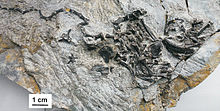Pappochelys
| Pappochelys | |
|---|---|

| |
| The holotype specimen of Pappochelys | |
| Scientific classification | |
| Domain: | Eukaryota |
| Kingdom: | Animalia |
| Phylum: | Chordata |
| Class: | Reptilia |
| Clade: | Pantestudines |
| Genus: | †Pappochelys Schoch & Sues 2015 |
| Type species | |
| †Pappochelys rosinae | |
Pappochelys (παπποχέλυς [πάππος (grandfather) + χέλυς (turtle)] meaning "grandfather turtle" in
Description

Pappochelys had a wide body, small skull, and a long tail that makes up about half of the total body length, which is up to 20 centimetres (8 in). The skull is pointed with large eye sockets. Several turtle-like features are present, including expanded ribs and
Discovery

Fossils of Pappochelys come from a rock group in Germany called the
Relationship to turtles
The placement of turtles on the reptile evolutionary tree has been a point of contention in the past few decades because of a disagreement between morphological and molecular data. Based on anatomical data alone, turtles appear to fall within


Of the reptiles that most closely resemble Pappochelys, Eunotosaurus was originally classified as a parareptile and Odontochelys has always been classified as a stem-turtle (stem-turtles are taxa more closely related to turtles than they are to any other living reptile group, but are not themselves turtles).
|
stem-turtles |
In their description of Chinlechelys, Lichtig & Lucas (2021) criticized Schoch & Sue's hypothesis of turtle origins, particularly the idea shells evolved from broadening ribs with no osteoderms involved (as Pappochelys apparently indicates). Instead, they proposed Pappochelys was actually a sauropterygian related to placodonts while turtles were derived parareptiles.[8]
Paleobiology
The claystone bed in which fossils of Pappochelys were found was likely deposited in a lake setting,[3] suggesting that Pappochelys may have been semi-aquatic like modern turtles. Although Pappochelys lacked a fully formed shell like modern turtles, its thickened bones may have helped reduce the body's buoyancy, making it a more adept swimmer.[1] However, otherwise the anatomy has no signs of a fully aquatic lifestyle[3] and only few adaptations for swimming. In addition, a histological study found that its limb bones had a thick outer wall and small, open (rather than spongy) medullary cavity, like only a few aquatic reptiles and completely unlike modern aquatic turtles. These features have also been recorded in terrestrial reptiles such as the modern lizard Sceloporus and Eunotosaurus, another genus of pantestudine with burrowing adaptations. This may indicate that Pappochelys had a burrowing or modestly aquatic lifestyle, rather than a fully aquatic one.[9]
References
- ^ (PDF) on 2015-06-26.
- Washington Post.
- ^ ISBN 9781421428680.
- PMID 15306328.
- .
- .
- .
- S2CID 233454789.
- PMID 31320733.
External links
 Media related to Pappochelys at Wikimedia Commons
Media related to Pappochelys at Wikimedia Commons
